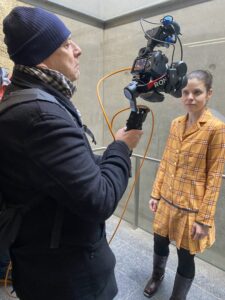Le travail de Rémy Markowitsch (né en 1957 à Zurich, vit et travaille à Berlin) puise souvent dans la littérature classique pour évoquer les pulsions cachées qui traversent la société.
Le point de départ de Juliens Maus est la légende de Saint Julien l’Hospitalier, telle que racontée par Gustave Flaubert dans Trois Contes (1877).
Après avoir tué intentionnellement une petite souris blanche dans une église, le jeune Julien est saisi d’un désir irrépressible de chasser et de tuer des centaines d’animaux. Mais cette cruauté n’empêchera pas qu’après une vie alternant sauvagerie et pénitence, il accède au paradis.
Inspiré par un vitrail de la cathédrale de Rouen, le récit de Flaubert explore les notions de péché, de remords et de rédemption, offrant une double lecture à la fois christique et érotique.
La sculpture de l’artiste et la vidéo qui l’accompagne — accessible via QR code et projetée dans la tour Vauban — reprennent ces évocations puissantes pour canoniser la première victime de Julien : la petite souris blanche.
